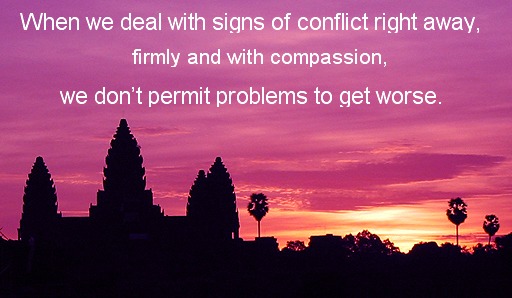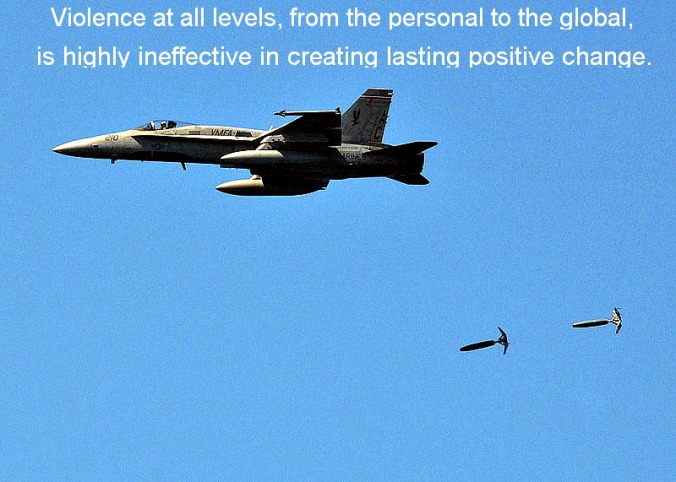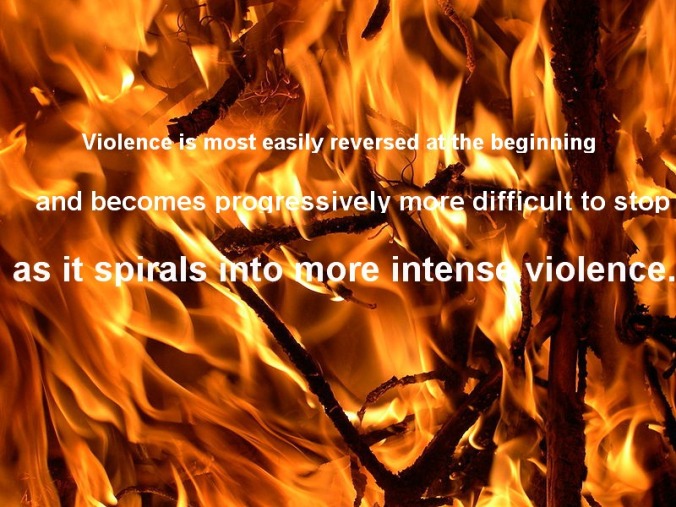
Working in a retail job, you think you’ve become accustomed to bad behavior on the part of children as well as parents. But you are appalled to see a mother use an umbrella to spank a small boy.Will intervening threaten the child or endanger your job?
Walking through a grocery store parking lot, you notice a crying toddler in the grocery cart and a woman screaming at the child as she loads packages in her car. She slaps the child’s face and arms as you walk past.If you say anything will you make it worse?
Looking out your apartment window you see a young man standing next to a motorcycle, pushing and yelling at a teenaged girl from the building who seems to be his girlfriend.Would the police consider this abuse if you called?
Leaving work later than usual on a wintry evening you have the feeling you’re being followed. As you turn a corner you see an ill-dressed youth close behind you. He holds out a gun and asks for money.Are there any options that don’t leave a victim?
Driving past a cluster of youths on a city street, you realize that they are clubbing a boy with a piece of wood. It’s safer for you to continue in traffic, but you want to defend this teen from his aggressors.Can your heart and head agree on a course of action?
Violence is familiar. It’s highlighted in news, movies and video games. It erupts in our homes or homes nearby, even if few people admit it. It’s insidious and damaging. Violence at all levels, from the personal to the global, is highly ineffective in creating lasting positive change.Yet we know very little about nonviolence. We may be aware of Mohandas Gandhi’ssatyagraha. This philosophy, which Gandhi called “soul force,” inspired the passive resistance successfully used in the U.S. civil rights movement and the healing honesty of South Africa’s Truth and Reconciliation Commission. But most people don’t think these approaches are relevant. In fact, pacifism is often confused with those who are passive. Nothing could be further from the truth. Nonviolence requires a level of conviction and inner strength that makes violence look easy.
Nonviolence doesn’t imply lack of anger or conflict. Strong emotions like anger can be a catalyst for change; rallying us to become more aware, to take action or to seek help. Conflict is an inevitable part of human interaction. Dealing with conflict constructively, creatively, and with mutual regard lets conflict serve a useful purpose.

The tactics of nonviolence have worked throughout history. But, as it’s often said, history is written by the victors. Scholar Antony Adolf writes inPeace: A World History, “The champions of peace, momentous and everyday, intellectual and activist, expert professional and lay, have for too long been considered exceptions that prove this rule, when in actuality without their efforts there may not have been a history to live, let alone write.”
Nonviolent principleswork today, although they continue to be little known. According to theHuman Security Report, from the University of British Columbia, peacemaking efforts by the United Nations as well as voluntary activism continue to have a powerful impact. Although little reported by the media, the world has seen a significant decline in violence. The overall number of armed conflicts has declined by 40% in the last 16 years with the deadliest conflicts dropping by 80%. Three decades ago 90 countries were governed by authoritarian regimes; now fewer than 30 suffer this oppression.
The efforts of individuals may make the biggest difference. Paul Hawken writes inBlessed Unrest: How the Largest Social Movement in History Is Restoring Grace, Justice, and Beauty to the Worldabout the efforts of caring people everywhere around the world. Before the abolitionist movement there were pitifully few groups working on behalf of others. Since that time the number of people collaborating for the greater good has grown at an unprecedented rate. Now there are over a million organizations seeking environmental sustainability, social justice, cultural preservation, and peace. Hawkin says that never before in history have there been so many people working on behalf of others.
In fact the success of humankind is based on peaceful person to person, group to group interaction. The unwritten span of prehistory makes up 99% of our time on earth. Most anthropologists affirm that cooperation was pivotal for survival during this long stage, when people lived in nomadic hunter-gatherer bands. A lone human would not last long. No claws, fangs or heavy fur protected them. Interdependence was key. Together our forebears developed language, healing arts, and methods of procuring food. Cooperative efforts in child rearing, protection from predators, and shelter from the elements gave them a survival edge. This entire period of our development was characterized by generally peaceable human interactions. There’s minimal evidence of warfare in this span of prehistory. Planned aggression against others likely developed around the start of agriculture.
From the larger perspective of time we are barely out of prehistory, still adjusting to the complexities of civilization. As anthropologist Douglas P. Fry notes inBeyond War: The Human Potential for Peace, cooperation and empathy accurate represent our species. Violence is not “human nature.” We flourish best withgentle nurturanceand continuedcooperation.

So what’s the first nonviolence principle we should know? De-escalation. A major characteristic of violence, verbal as well as physical, is that it tends to escalate. It is most easily reversed at the beginning and becomes progressively more difficult to stop as it spirals into more intense violence. Those who study the effects of intervention in violent situations have found when others object or actively intervene, their efforts tend to slow or stop the violence. Dr. Ervin Staub, who survived under Nazi rule, reports inThe Roots of Evil: The Origins of Genocide and Other Group Violence, that the Khmer Rouge in Cambodia and the Nazis in Germany began their campaigns of genocide with small persecutions which citizens allowed to continue. He reports that action by “bystanders” (those who are not victim or perpetrator) empowers the victim and diminishes the power of the aggressor. But ignoring the suffering of others allows the violence to escalate.
That’s true in our daily lives as well. When we deal with signs of conflict right away, firmly and with compassion, we don’t permit problems to get worse. That’s just one principle of nonviolence. The more we know about nonviolence, the wider the range of options we have to choose from in each situation.
What about situations you might encounter at work, in a parking lot, in your neighborhood, while driving or walking down the street? All of the circumstances described at the beginning were actual experiences. Fortunately the people facing these situations had studied nonviolence and they decided to take a stand.
The store clerk who witnessed a mother using an umbrella to hit a child intervened quickly. She stepped next to the mother and said quietly, “You have to stop that right now.”
The mother was furious. She protested that she had the right to discipline her child. The clerk agreed, keeping her voice low and calm, “Yes, you do. But how you do it makes a difference.”
She listened as the child’s mother continued to argue with her, then said, “Can I tell you something? I’m sure my mother took good care of me. But she got mad easily and hit me a lot. Not one person ever stuck up for me. When I grew up I decided I’d never speak to her again and I haven’t. I’m not saying it’s the same for you and your child, but I just had to say something.”
The mother responded by describing to the clerk the many ways she was a good mother to her son. The tone of the woman’s voice as well as her attitude changed as she focused on her parenting strengths. On her way out of the store she picked up the child and said, “Momma loves you even when she’s mad, you know that don’t you?”
~~~~~
The man about to walk past the woman slapping her toddler in the parking lot had an idea. He reached into his pocket, pulled out a ten dollar bill and covertly dropped it near them. He made a show of leaning over and finding the bill. He held it out to the woman and asked if it might be hers.
Although she insisted it was not her money he gave it to her, considering it money well spent. As they spoke he made some positive observations about her child. He sympathized with her difficulty, mentioning that when his kids were young he found it easiest to take along a few snacks and small toys to keep them busy. They talked and by the time he walked away the woman and toddler were both smiling. His simple act stopped the violence and for that moment he’d brought a positive element to the situation.
~~~~~
The neighbor who witnessed a motorcyclist pushing and yelling at his girlfriend decided he couldn’t stand by. He walked casually out of his apartment and just as he was about to pass the couple he paused. When the boyfriend noticed his glance the neighbor made an admiring comment about the bike. His attention disrupted the abuse. He and the young man struck up a brief conversation about motorcycles. His observations on treating the bike well may just as easily have been about treating a person with loving attention. By interrupting the abuse he offered the girl time to leave, if she chose, and he hoped it established a rapport that might be helpful if the girl wanted to talk at a later time.
~~~~~
The commuter walking late along a cold, dark street confronted by a gunman was afraid he might lose his wallet, coat, and perhaps his life. He also empathized with the poorly dressed youth. Ignoring the gun and disrupting the man’s plan to make him a victim, he said, “It’s cold. Why don’t you take my jacket?”
As he took off the coat he kept talking about the wintry weather. He offered to purchase food, even give the young man money. The aggressor was confounded by the man’s generosity and lack of fear. Acting embarrassed, he refused the food, money and jacket. The commuter insisted the youth take the jacket as a gift. He may have gone home without his own jacket but he transformed a potential crime into an encounter of compassion.
~~~~~
The woman who drove past teens pummeling another youth with a piece of wood chose to stop her car in traffic. Standing at her open car door she called to them, telling them to stop what they were doing. They were surprised but held their ground. One jeered at her asking why she would care about some kid who was a stranger to her while the others laughed. She answered that she cared about all of them. And then she said she would stop if she saw any of them being hurt.
“Next time I might need to stop for you,” she told the youth who questioned her. Anger defused, they walked away. She left when she saw the youth who’d been hurt get up and walk in the other direction.
~~~~~
These people chose action over despair. Their creative, unique solutions served as peaceful de-escalations of violent situations. They may not have eliminated the causes or “solved” the issue but they pointed a way out. Making a stand does make a difference.
Our anger and our concerns about violence can be shaped into purposeful, peaceful action. This is the greatest antidote to despair.
—
Laura Grace Weldonis an author, farm wench and relentless optimist. Read her articles, essays, and poetry atlauragraceweldon.com. An earlier version of this piece appeared inNatural Life Magazine. It is cross-posted here with permission from the author.

Fabulous article – inspiring. DG